如同 SmoothQuant 論文裡的圖, 在 memory size 已經跟不上算力和模型大小情況下, memory bandwidth 已經變成 bottleneck. 如何降低 memory 使用量將變的很關鍵, 因此 Activation-aware Weight Quantization (AWQ) 這篇文章就專注在 Weight Only Quantization (WOQ), 顧名思義就是 weight 使用 integer 4/3 bits, activations 仍維持 FP16.
如何降低 memory 使用量將變的很關鍵, 因此 Activation-aware Weight Quantization (AWQ) 這篇文章就專注在 Weight Only Quantization (WOQ), 顧名思義就是 weight 使用 integer 4/3 bits, activations 仍維持 FP16.
因為 computation is cheap, memory is expensive.
Intel® Neural Compressor 有實作 WOQ 裡面有 AWQ
以下內容直接筆記 MIT SongHan 教授的課程內容[slides], [Video]
 將 Weights quantize 到 4/3 bits 對 memory bandwidth 會有幫助, 但是直接使用 round-to-nearest (RTN) performance 會壞掉, 就算是使用 group-wise/block-wise 的方式也是沒用.
將 Weights quantize 到 4/3 bits 對 memory bandwidth 會有幫助, 但是直接使用 round-to-nearest (RTN) performance 會壞掉, 就算是使用 group-wise/block-wise 的方式也是沒用.
作者發現如果保留特定的 $1\%$ 的 weights 仍舊是 FP16 的話 (其餘都是 4/3 bits) 就可以保留住 performance. 如下圖顯示.
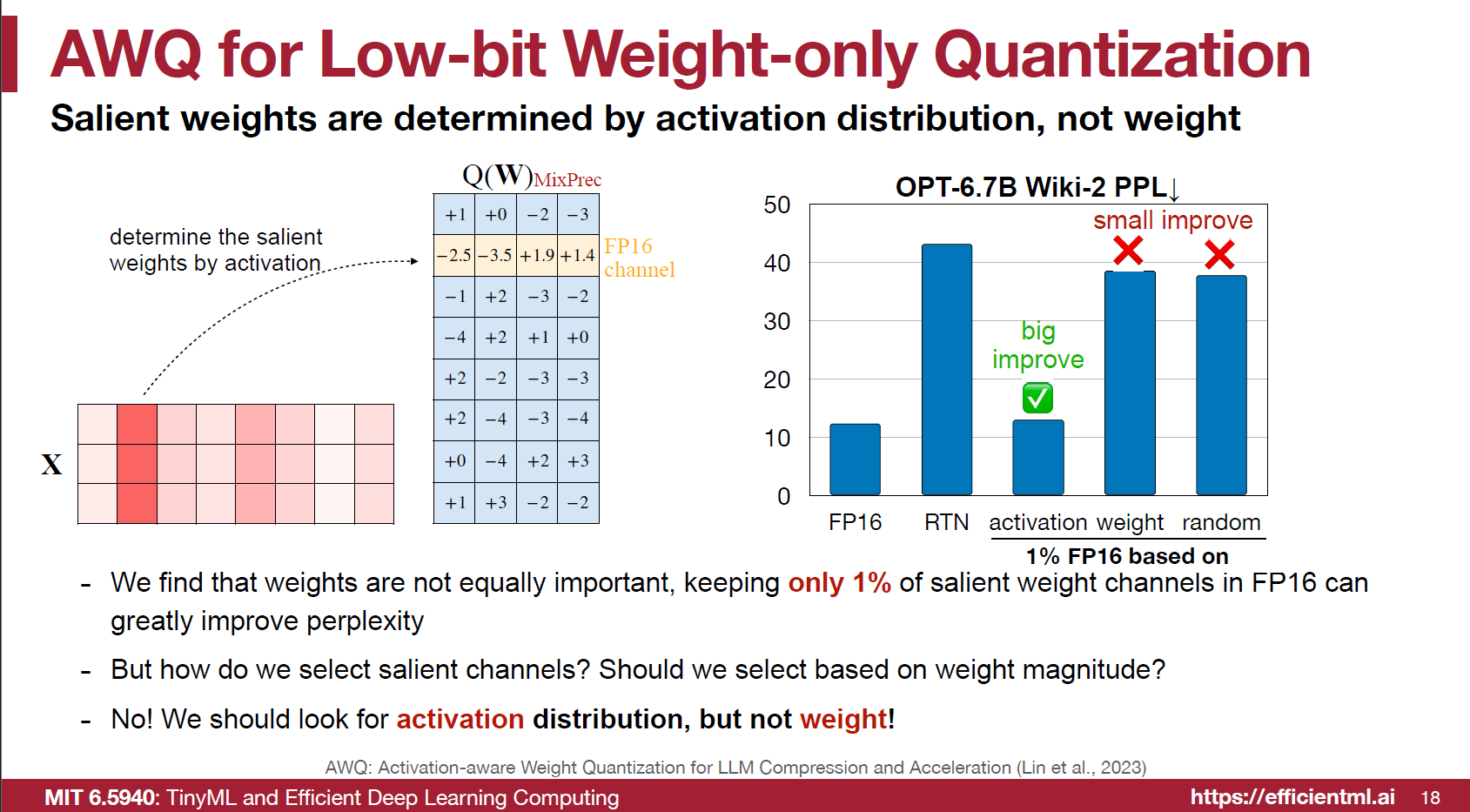 特定的 weights 是那些呢? 因為 output activations 是 input activations 乗上 weights, 所以應該要看 activations 不能只單獨考慮 weights 大小.
特定的 weights 是那些呢? 因為 output activations 是 input activations 乗上 weights, 所以應該要看 activations 不能只單獨考慮 weights 大小.
還記得在 SmoothQuant 觀察到的現象嗎? activations 的 outliers 是以 per-channels 方式存在的, 也就是說 channels 之間差異可能很大, 但同一個 channel 內的值分佈都比較接近
圖中的 activation $X$ 的 row 表示 token (frame) 維度, column 表示 channel 維度. 所以對應到 weights 的話 input channel 就是 $W$ 的 row vectors.
要保留的那 $1\%$ 的 row vectors 的 weights 就是找對應 $X$ 的 column vectors 總和 magnitude 比較大的那些來保留. 見下圖 (b) 但能不能連 FP16 都不要, 最好全部都是 INT 因為這樣對 HW 比較友好.
但能不能連 FP16 都不要, 最好全部都是 INT 因為這樣對 HW 比較友好.
作者發現透過一個簡單的 scaling 操作就有幫助 (其實概念一樣很像 SmoothQuant)
類似 SmoothQuant 的方式, 先對 quantization 之前的 Weights 乘上 scale $s$, 對應的在 input activations $X$ 除上 $s$, 如果沒有做 quantization 數學上就是等價.
下圖顯示對第 2 個 input channel 設定 $s=2$. 這麼做直接無損 performance.
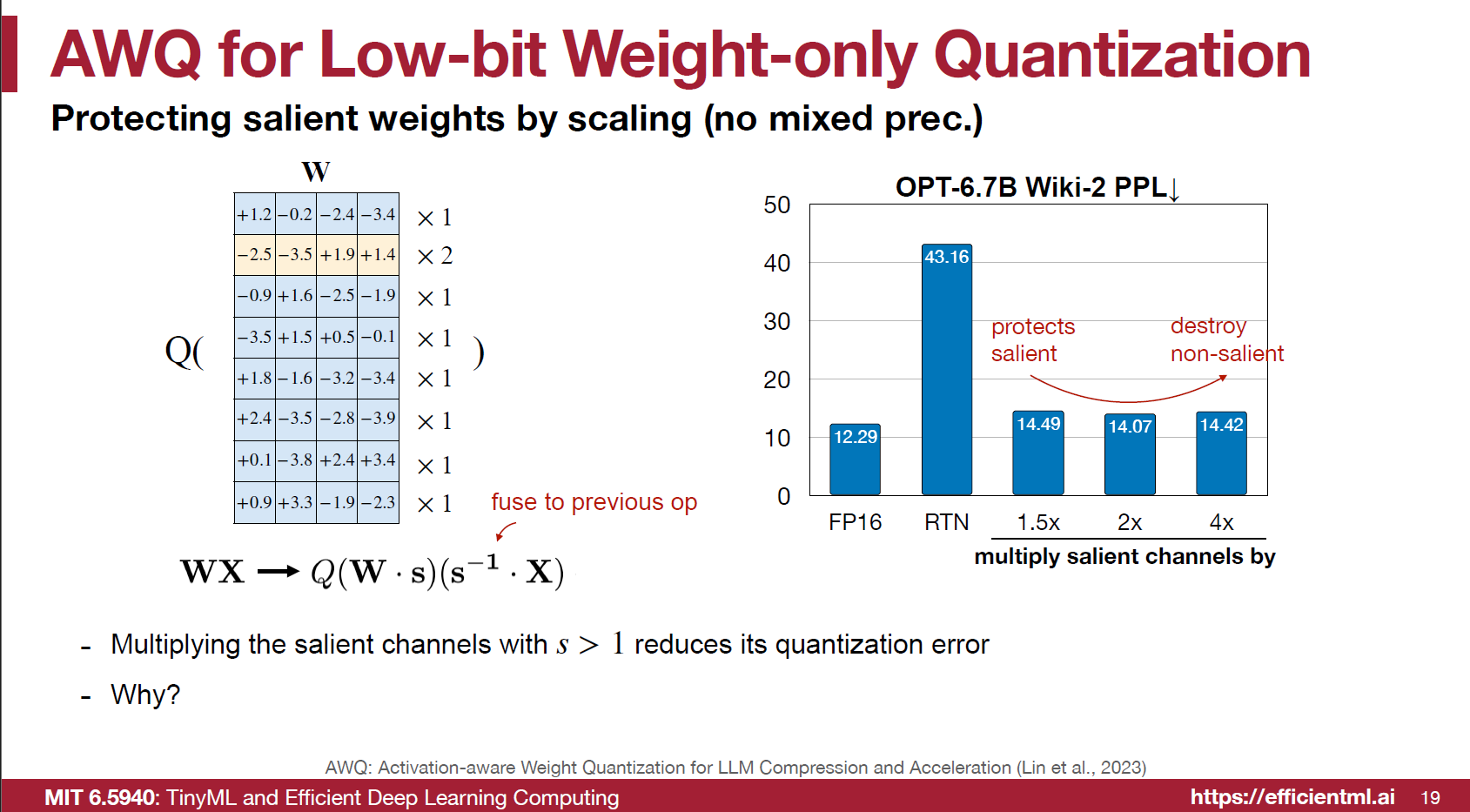 但是為什麼呢?
但是為什麼呢?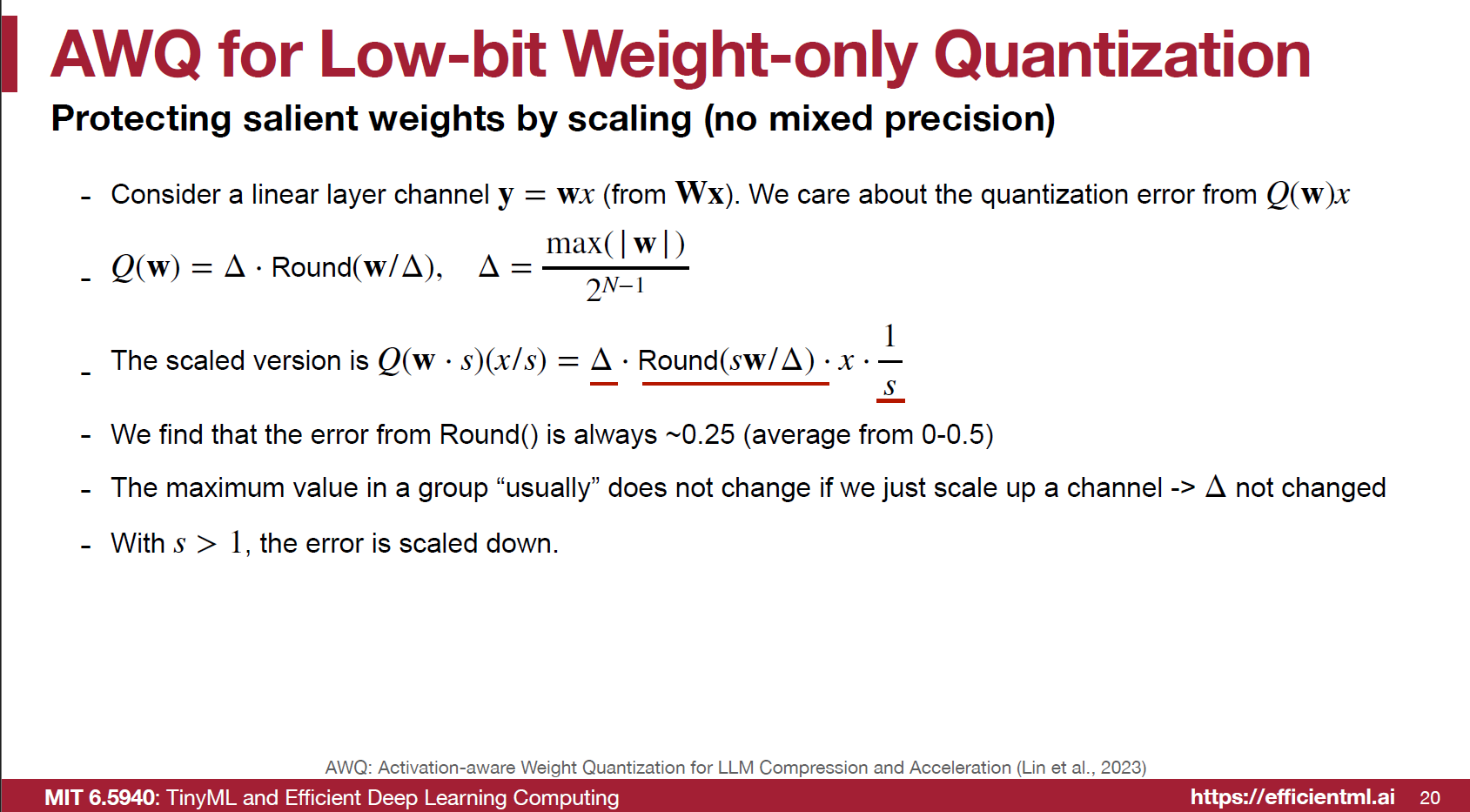 原來 output activation 為
原來 output activation 為
$$\tilde{Y}=Q(\mathbf{w}\cdot s)\cdot \mathbf{x}/s=\Delta\cdot Round(s\mathbf{w}/\Delta)\cdot \mathbf{x}/s$$ 互相對比一下, 注意到由於 $\mathbb{E}[Round(\mathbf{w}/\Delta)]=\mathbb{E}[Round(s\mathbf{w}/\Delta)]=0.25$, 當 $s>1$ 的時候 $\tilde{Y}<\hat{Y}$, 使得 output activations 的 dynamic range 變小了, 等同於讓 outliers 變小更容易 quantization 了.
注意到這裡有個假設: $\Delta$ 不變的條件下. 這通常可以滿足, 因為實務上設定 $1
下面這段 codes 是 SongHan 課程裡的 Lab4.ipynb
|
|
注意到 input_feat 使用 hook 事先對 calibration data 蒐集好的, 用來找出 $1\%$ 的那些 salient weight channels.
另外, 實際上我們不會對 input activation 除 scale, 而是將這個 scale 融進去前一層的 layer normalization weight 裡
|
|
如果是 Transformer 的 FFN layer, 則融進去前一層的 fc layer
|
|
我有點疑問, 做 AWQ 的 order 是不是有影響? 譬如後面的 layer 做 AWQ 的時候會讓前一個 layer 除上 scale, 但如果前一個 layer 已經先做過 AWQ 了, 那不就白做了? (教授課程的作業裡面會讓我有這種疑問, 但課程作業就這樣設計了, 感覺是沒影響. 還是因為不會動到同一個 channel?) 這個疑問待後續解決.
最後, 比較好的做法是用一個 calibration data 做 $s$ 的 grid search. 而 search 的目標函式為 output activation 的 quantization error:
$$\begin{align} 𝐋(\mathbf{s})=\lVert Q(\mathbf{W}\cdot \mathbf{s}) (\mathbf{s^{-1}} \cdot \mathbf{X}) - \mathbf{W}\mathbf{X} \rVert, \quad\mathbf{s}= \mathbf{s_X}^{\alpha}\\ \mathbf{s}^* = \text{argmin}_{\mathbf{s}} 𝐋(\mathbf{s}),\quad \alpha^*=\text{argmin}_{\alpha} 𝐋(\mathbf{s_X}^{\alpha}) \end{align}$$ 其中 $\mathbf{s_X}$ 是 input activation 的 magnitude, $\alpha\in[0,1]$, $0$ 表示沒有 scale; $1$ 表示最強的 scale. Grid search 是對 $\alpha$ 做.
最後實驗結果顯示對 LLMs, OpenFlamingo 做到 4/3bits 的 weights quantization 很有效: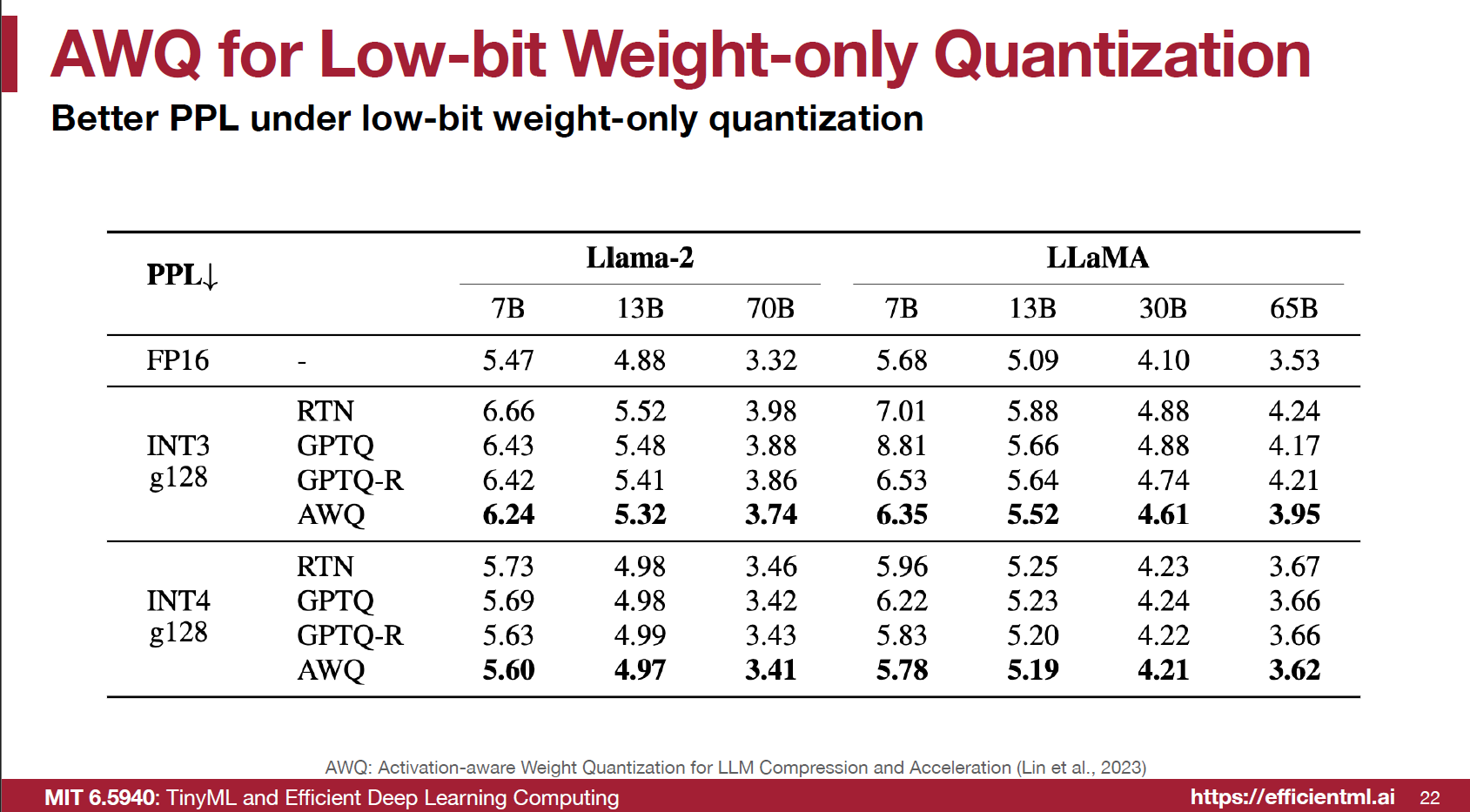
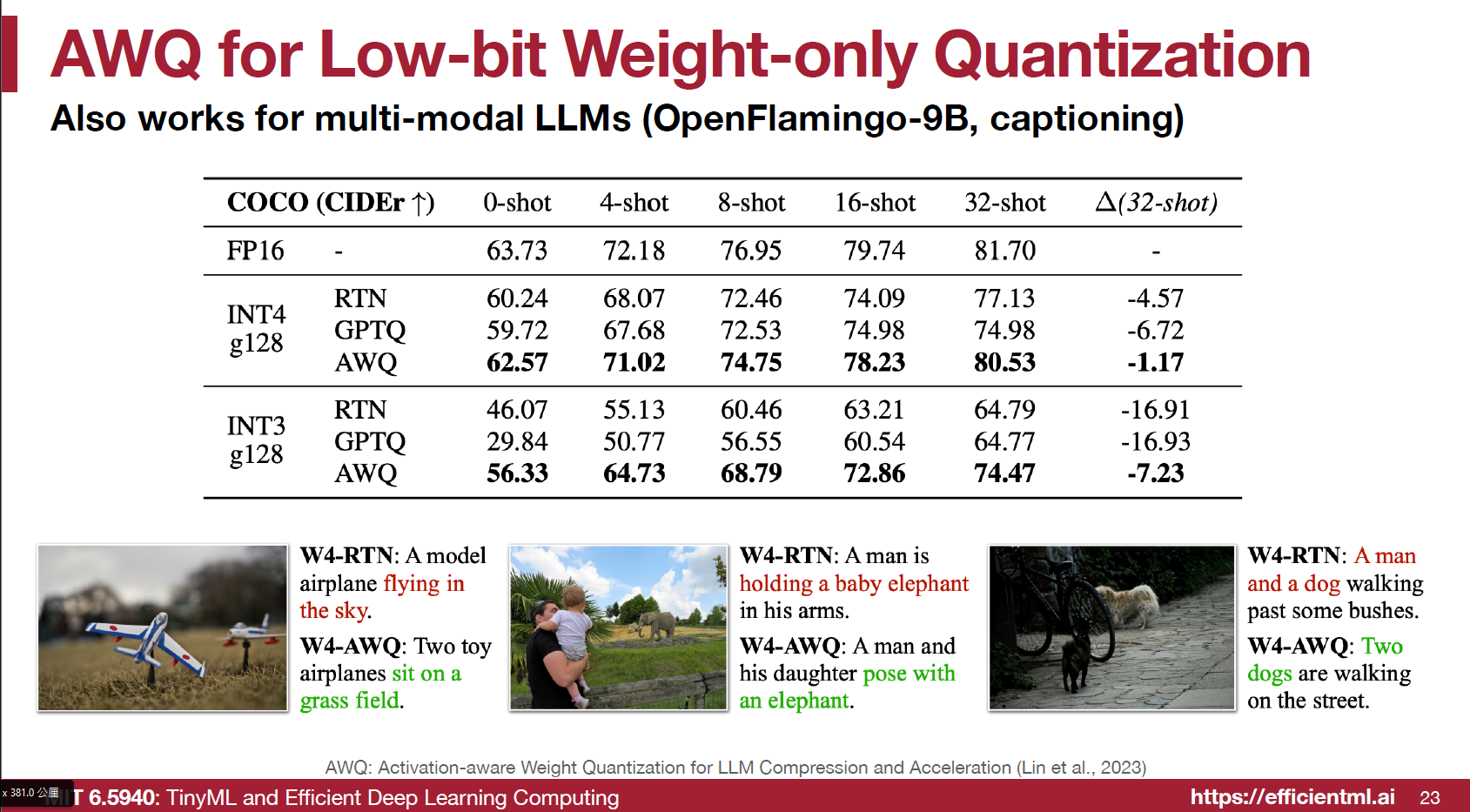
 這裡實驗如果是用 per-channel 會效果不好, 所以建議搭配 per-vector 或稱 per-group quantization.
這裡實驗如果是用 per-channel 會效果不好, 所以建議搭配 per-vector 或稱 per-group quantization.
References
- AWQ: Activation-aware Weight Quantization for LLM Compression and Acceleration, [arxiv]
- MIT HAN Lab, Course: TinyML and Efficient Deep Learning Computing [slides], [Video]
- Intel® Neural Compressor‘s WOQ